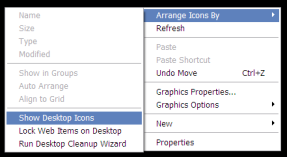Less is more
 Some time ago I've posted a couple of ideas around productivity and distractionless computer environment. Since then I continue trying to optimize my computer experience here and there.
It is always interesting to know what ideas others have about problems you are thinking about. So it was very interesting for me to read how Leo Babauta of Zen Habits approaches his computer experience. A lot of good ideas there.
Some time ago I've posted a couple of ideas around productivity and distractionless computer environment. Since then I continue trying to optimize my computer experience here and there.
It is always interesting to know what ideas others have about problems you are thinking about. So it was very interesting for me to read how Leo Babauta of Zen Habits approaches his computer experience. A lot of good ideas there.
Iconless desktop. Great idea! Desktop is not a junkyard. On Windows XP it is as simple as right-click on the desktop -> Arrange Icons By -> Show Desktop Icons.
"Light" menubar. Now I switched from autohiding my Task Bar to completely removing it from the screen: only 2 pixels at the top of the screen. No more annoying appearances of the Tool Bar when your mouse is near the edge. You can still use Win-key to access the Start menu and Alt-Tab to switch between windows.
Keyboard shortcuts instead of icons. Brilliant! This is something that I started adopting very actively. On Windows XP you do not even need to install additional software tools: right-click on the icon in the Start Menu -> Properties, click in the Shortcut key box and select shortcut for an application.
Find your way to effective computer experience.These and other small tricks can take you one step away from chaos and give you some precious time to do what you do best - create!
Selling to businesses: sign of stars
Some days ago I watched David Heinemeier Hansson's presentation on creating a profitable startup where he suggests that is generally more effective to sell to businesses than individual customers. That was kind of a useful observation that I, not being very experienced in running businesses, took for granted.
 In several days I concerned myself with checking out latest article in Joel Spolsky's column in the Inc.com magazine. It happened to be How Hard Could it Be: A Real Cool Customer. It was like one of those not rare alignment of stars that make certain idea pop-up again and again.
In several days I concerned myself with checking out latest article in Joel Spolsky's column in the Inc.com magazine. It happened to be How Hard Could it Be: A Real Cool Customer. It was like one of those not rare alignment of stars that make certain idea pop-up again and again.
In his article Joel gives great arguments on why you'd better sell to businesses and not to consumers:
Businesses will happily spend large sums of money on fixed costs, because those costs can be spread out across so many of their customers.
Also Joel discusses this with Jeff Atwood in stackoverflow podcast #5, which I listened to yesterday.
This line of coincidences made me think a little about this idea. Being myself a part of a business I see that businesses pay easier not because they have lots of money (well, not only), but also because often for businesses it is easier to evaluate the value of certain costs. Businesses can see how "costs can be spread out across so many of their customers" and what they would have in return. Individuals usually do not go that far to do such kind of analysis and therefore their decisions to buy tend to be based on momentary considerations.
Erosion of ideas
I recently subscribed to TechCrunch and so far I noticed 2 things:
- This blog literally chocks up my RSS aggregator (which happens to be Google Reader) so that I have to modify my reading habits not to miss posts from others feeds. Near dozen posts a day may be not that big number, but it definitely outperforms my other subscriptions.
- Every once in a while TechCrunch posts really touch my soul and make me stop to think.
 One of such posts was What To Do With Failed Startup IP? It was always sad for me to see humans' ideas, aspirations, accomplishments becoming thrash. Be it physical objects or results of intellectual effort.
One of such posts was What To Do With Failed Startup IP? It was always sad for me to see humans' ideas, aspirations, accomplishments becoming thrash. Be it physical objects or results of intellectual effort.
I do not remember where but once I've read or heard that less than 10% of Earth population contribute to development of mankind civilization and this percentage is decreasing all the time. I think this "total productivity" can be greatly improved if we figure out a way not to let priceless man-hours of mental and other efforts be thrown to trash cans of oblivion and natural erosion.
Advanced Selling Podcast revisited
 Going out for a walk with my 3-months old daughter I took my iPod loaded with older and recent episodes of Advanced Selling Podcast. And again I enjoyed all the episodes just I did last time when I had Advanced Selling Podcast "listening session".
Continuing my walk I tried to understand what are Bill Caskey and Bryan Neale saying that touches me. And I understood that we are sharing the same belief that a person in order to be truly successful in whatever position she is in has to have constructive attitude. Here "attitude" means system of values which is not only declared but also followed and "constructive" means that it is geared towards making this world better at least for somebody.
Going out for a walk with my 3-months old daughter I took my iPod loaded with older and recent episodes of Advanced Selling Podcast. And again I enjoyed all the episodes just I did last time when I had Advanced Selling Podcast "listening session".
Continuing my walk I tried to understand what are Bill Caskey and Bryan Neale saying that touches me. And I understood that we are sharing the same belief that a person in order to be truly successful in whatever position she is in has to have constructive attitude. Here "attitude" means system of values which is not only declared but also followed and "constructive" means that it is geared towards making this world better at least for somebody.
Like writing is not about writer, but about reader; selling is not about seller - it is about buyer; engineering is not about engineer - it is about user. It is possible that such kind of attitude does not give immediate dividends, but it will pay off in the long run for sure. So I would suggest checking out Advanced Selling Podcast (you can subscribe with iTunes) not only to become better at sales, but also to find out how this new way of thinking can be of service for your work.
How 30-day trial is different from 30-day money back guarantee?
 When you download a trial version of a product you do not have any obligation to use or even install the product. The only your investment so far is time and traffic to download. If you do not have time to test drive the product today or tomorrow, no problem - you can download it again. If you installed it and do not like it, not a big deal - uninstall and go search for an alternative. Like it? Enter activation code and there you go!
When you download a trial version of a product you do not have any obligation to use or even install the product. The only your investment so far is time and traffic to download. If you do not have time to test drive the product today or tomorrow, no problem - you can download it again. If you installed it and do not like it, not a big deal - uninstall and go search for an alternative. Like it? Enter activation code and there you go!
Now you've bought a product with money back guarantee. You think "I need to try it. The more time I test it the more chance I'll catch the problem and get my money back." You do not have a single day to postpone this, you've already invested money into it. The positive case is simple - you simply continue using the product.
The negative case is way more difficult. One day you decide "This piece of software isn't worth the money I spent. Lets get them back." You start looking for the instructions how to apply for money back. You know what? No one even bothered with providing you such instructions! Developers did not want to think or probably even did not know about such feature of their product. You end up writing to sales with a claim for money back. I would imagine they reply with something like "We can offer you new updated version of our product. We are sure that if you try it you will reconsider!".
I bet you will not reconsider, they just ask for additional investment of time from you. And the money back begins! But technically and legally that is not an easy process. And I mean it. The situation is even more tricky if you bought the product from reseller, not the original vendor which offers the money back guarantee. But you go through it and get your money back.
 Now you get an e-mail "It is unfortunate that our product failed to meet you expectations. Blah-blah-blah. Please help us improve by telling what was wrong." Are they serious!? They've just wasted your time and probably money (shipping is not refunded) and made you go to competitor and now ask you to invest more time in helping them become better! Well, they ask for to much.
Now you get an e-mail "It is unfortunate that our product failed to meet you expectations. Blah-blah-blah. Please help us improve by telling what was wrong." Are they serious!? They've just wasted your time and probably money (shipping is not refunded) and made you go to competitor and now ask you to invest more time in helping them become better! Well, they ask for to much.
You see, this whole money back guarantee thing is not at all about you. It is all about the vendor.
Want to attract customers and make sure their bad stories do not get even worse? Offer trial versions to let users test drive your product with as less effort from their side as possible.
Bug fixing? Oh, come on!

More choice is bad?
Recently the food superstore I usually visit to buy food for my family introduced new size of parcels that they sell at the check out. Generally it is a good idea to offer smaller (and thus cheaper) parcels for those who do not need large ones. But let's look at this new offer from another point of view. Earlier the dialog at the check out started with
— Do you need a parcel? — Yes, thank you. (or No, thank you.)
And now it goes as
— Do you need a parcel? — Yes. (or No, thank you. And that is ok.) — Large or small one? — Hm... Well... I guess, large one.
You see, now selling a parcel takes at least twice as much time as it did before. And the new offer that was aimed at increasing customer satisfaction those on the line are really irritated by the process of parcel selection.
In fact, the process is more than two times slower. The reason is that first question does not really require a decision from you. You kind of know beforehand whether you need the parcel. But the second question gives you choice and asks to decide. And that is where one really needs to take his time and think.
Generally speaking, choice is good when it adds real alternatives. And in that case the choice should be supported by effective decision making process so that overall efficiency is not affected.
UML Color Modeling and DNC sample
I've come across a good example of Color Modelling and DNC use by Stephen Palmer: Modelling in Colour: Using the DNC. Recommended.
Know what clients expect of you
Every once in a while I see situations which have fairly strait forward projections on software development (and in fact other customer oriented businesses). A week and a half ago I came to my bank to order a reissue of my MasterCard Standard which was about to expire. They said that for my being a good client they can offer increased credit line. I agreed. But this operation required me close my expiring card and open a new one. Not a big deal, almost the same process as with simple reissue. So I got back home waiting for my new card. The more so I wanted to buy some books from Amazon and pay for ACM membership.
Several days ago I came to my bank again to get my new credit card. And (what a surprise!) I got MasterCard Electronic which can not be used for online payments! I asked them: why?! They said because Electronic costs $2 whereas Standard cost $5. But it can not be used for online payments! Frankly, the only value of this card for me was that I can use it to pay online. And they knew it because I came to them some time ago to relax restrictions on Internet payments for this card. After all they could have called me to ask which card I wanted, but they did not. Bank will issue a new card of required class for $5, but I will get it a week later than I originally expected. And I’m frustrated about that.
Message here is that you should know what customer expects of you and you should match his expectations. If do not know – ask him, offer him choices, help him to choose, but never make groundless assumptions that will frustrate your customer.
What optimization is really about?
Every observation you make in day-to-day life can draw useful analogies to your professional activities. Today while I was serviced by the girl at the cash register at the super store I noticed that she wanted to optimize the process of scanning product codes. She grouped units of the same products to scan their code only once and correct quantities in the register. Theoretically this should have taken less time than scanning code of each product unit. In fact, because of this “optimization” I had to stay at the register longer that it would without optimization. Grouping of the units the same products took her very long. So although the cashier made fewer operations the whole process took longer. The main lesson from this observation is that you should optimize the whole system (end to end sequence of steps) not separate steps or parts of process. Theory of constraints tells us that every process (or system) has a bottleneck and it is this bottleneck that should be addressed by optimization. So be sure to measure and keep an eye on performance of the whole system while optimizing.


